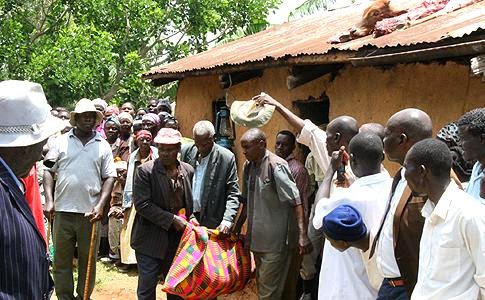TACHONI HEROIC SEND OFF
The Tachoni take their culture very seriously. In August 1997, an eighty one year old Tachoni
elder by the name of Mzee Japheth Wanyama Kimingichi from Tavani village, sitabicha sub
location, Ndivisi location, Bungoma East District grabbed the people’s attention when he was
given a traditional burial. The community hero had finally been brought down.
Mzee Wanyama was born in the year 1918 in Ndivisi location. He was the son of Kimingichi and
grandson to Lutiali. He was a prominent Tachoni leader. Mzee Wanyama was famously known
by his proficiency in bicycle repair. He was stationed a few meters away from Ndivisi post office
(now Jasho bar) on Ndivisi market. He had won trust of the inhabitants of Ndivisi area and the
neighboring villages as his technique of bicycle repair and reliability in service provision. He
was also a farmer who grew food crops like maize, beans, cassava, bananas, sugarcane among
others. He also had a fish pond that hosted fish like omukoye and namabale. He was respected by
not only his subjects but by all who knew him. He was a teacher, a friend, a brother and a mentor
to many who knew his values. Mzee had five daughters and five sons who he instilled great
admirable values of love, unity and respect among them. He further took them to school where
they advanced in their education making them respected and productive members of the society.
The late Japheth Wanyama had a large piece of land which he never sold out like greedy wazee
do nowadays. Instead, he generously gave to his close friend Inguche from the Abasyoya clan.
The abasyoya clan’s relationship with Wanyama who was Omungachi was at omukulo level
though Wanyama surpassed that to yield a better and more fruitful relationship. He also gave
some land to Mzee Wekesa Masake’s late mum that is now in the hands of Mzee Masake.
Burial of a Tachoni elder in a shroud of fresh cow skin. Photo courtesy of NATION
Wanyama was also omusenamse (a traditional preacher) He was an overseer in several burial
ceremonies latest being at Mzee Bilauni.One had to be wise enough, to be made omusenamse
which was accompanied with several rituals performed. He was fully armed with the traditional
attire ikutusi, and ikutwa complete with omusila and indabusi in his hands. In those events, he
taught people on the traditions, customs, rituals, history and conduct among members of the
community. Being a role model, he preached water and took water. He upheld all the customs
and traditions ranging from circumcision, burial among others. Therefore, he had to go the same
way
When mzee passed on (23rdJuly 1997), instead of a coffin, he was wrapped in a shroud of fresh
cow skin before being interred in a ritual out of bounds for women and children. The head of the
beast was placed above the main entrance in accordance with ancient Tachoni burial customs.
Mzee Wanyama being an exceptional case was buried right inside his house. This was because
he was omutelwa (Born as the only son).Like the Bukusu, the Tachoni also practice what they
call okhusenaomuse three days after burial for certain categories of elders. That was done
followed by esinaoya, (a heroic send off where people dance with bulls) in the name of okhusaya
omwami (giving respect to the departed elder)
Don’t you just love the Tachoni culture?
Click HERE to
follow Samwana on Twitter
Click HERE to
add Samwana on facebook
Click HERE to visit
our website and leave a comment.

Comments
Post a Comment
Have your say